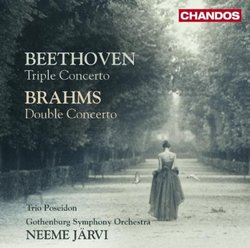| All Artists: Beethoven, Brahms, Gso, Jarvi Title: Triple Concerto / Double Concerto Members Wishing: 0 Total Copies: 0 Label: Chandos Original Release Date: 1/1/2010 Re-Release Date: 2/23/2010 Genre: Classical Style: Symphonies Number of Discs: 1 SwapaCD Credits: 1 UPCs: 095115156421, 095115156421 |
Search - Beethoven, Brahms, Gso :: Triple Concerto / Double Concerto
 | Beethoven, Brahms, Gso Triple Concerto / Double Concerto Genre: Classical
|
Larger Image |
CD Details |
CD ReviewsLesser known pieces from the masters still show their genius D. Lai | El Cajon, CA United States | 05/28/2010 (4 out of 5 stars) "The lush Chandos sound continues on these recordings of Beethoven's Triple Concerto (violin, cello, piano w/ orchestra) and Brahms' Double Concerto (violin, cello w/ orchestra). While these pieces pose a challenge to the listener (and quite possibly a challenge to the composers), with the soloing instruments seeming to struggle for their moment in the spotlight, the genius of both composers remains evident. The 1887 Brahms Double is a darker, sometimes brooding romantic piece. While the 1803 Beethoven Triple is a lighter classically-oriented (read: Mozart) piece. The soloists from Trio Poseidon and the Gothenburg Symphony Orchestra play with masterful control and fervor when called upon by maestro Neeme Jarvi. Overall, highly recommended versions of these lesser known pieces." In the Shadow of the Giants J Scott Morrison | Middlebury VT, USA | 03/26/2010 (4 out of 5 stars) "Recordings that include the Brahms Double Concerto and the Beethoven Triple Concerto are thick on the ground. Possibly the most treasured has been that with Richter, Oistrakh and Rostropovich with Karajan and the Berlin Philharmonic in the Beethoven and Szell and the Cleveland orchestra in the Brahms Great Recordings Of The Century - Beethoven: Triple Concerto; Brahms: Double Concerto / Oistrakh, Rostropovich, Richter. But there are also recordings with Zukerman, Kirshbaum and Browning Brahms: Double Concerto/Beethoven: Triple Concerto or with Rose, Istomin, Stern (a double CD that also contains Stern playing the Brahms and Beethoven violin concertos) Beethoven, Brahms: Violin Concertos among many others. This new recording with the virtually unknown Trio Poseidon, then, has huge competition. And I must say that it comes close but doesn't quite make the final cut. The Beethoven Triple is just a bit too polite and one senses that Järvi and the wonderful Gothenburg Symphony are not entirely committed by Beethoven's deceptively simple score.
On the other hand, the Brahms Double (with Trio Poseidon members Sara Trobäck Hesselink, violin, and Claes Gunnarsson, cello) is a very good reading, with red meat on its bones. Where Hesselink's tone in the Beethoven at times seems a little scrawny, in the Brahms it is full and vital. The gentle beginning of the middle movement with that glorious unison melody in octaves is heavenly as is the difficult but unshowy double cadenza toward the movement's end. After a slightly hesitant beginning, the soloists and orchestra really get into its spirit and conclude the Gypsy finale excitingly. I would not recommend these performances as first choices, but if you already have other versions and want yet another, you could do worse. Still, I much prefer the versions cited above. Scott Morrison" |

 Track Listings (6) - Disc #1
Track Listings (6) - Disc #1